How to clean a dry closet: features of cleaning peat and liquid types of dry closets
A dry toilet is an extremely convenient, aesthetically pleasing and environmentally friendly device.There are models that are suitable for a summer residence, and devices suitable for use in an apartment. They differ in type of processing, size, productivity and other characteristics.
When making a purchasing decision, you need to find out how to clean a dry closet, since its effectiveness depends on proper maintenance of this device. In this article, we will look at the features of caring for a dry toilet, for which we will first become familiar with the structure and operating principle of liquid and peat models.
The content of the article:
Design and specifics of operation of a dry closet
Hygienic devices of this type are quite diverse. Often biotoilets divided into liquid and peat. For the first, various liquid preparations are used as a means of waste processing, and for the second, dry peat.
Features of liquid models
Such devices usually consist of two parts. On top there is a toilet and a modification of the flush cistern, and below there is a spacious container for collecting and recycling waste. The upper part has a reservoir that is filled with water or a solution for flushing. There is also a pump, with its help liquid flows under pressure into the toilet.
The pump can be electric or mechanical, depending on the type of action it can be:
- pump-action
- piston
Electric pumps operate on mains power or batteries. They are very easy to use, the main thing is not to forget to promptly replace used batteries with new ones.Mechanical pumps are activated when you press a corrugated element. They do not require additional effort to flush. Owners note the high maintainability of such devices.
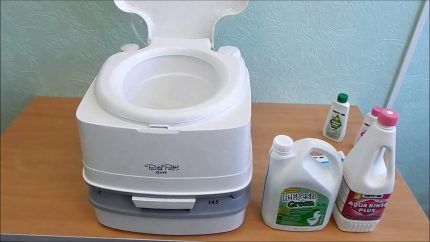
But pump-type mechanical models do not provide the ability to control the amount of liquid coming from the tank and the pressure inside it. The piston device is a little more difficult to use. The lever will have to be pressed several times to create the desired level of pressure.
Water is poured into the tank through the hole provided for this purpose. Of course, the toilet is covered with a lid. After using the dry closet for its intended purpose, you just need to press the pump lever to flush.
A durable rubber gasket is installed between the upper and lower sections, which prevents liquid from penetrating outward and also blocks unpleasant odors. There is a connecting valve that opens to move sewage to the lower compartment, and remains closed the rest of the time.
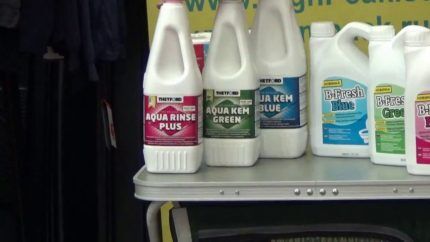
Two more mechanisms are provided to control the device: a pressure relief valve and a separating valve. The first is needed to protect the container from overloads, and the second connects the parts of the dry closet.
Some models have a very useful addition on the body of the lower tank - a fill indicator. It allows you to understand that you need to start the cleaning procedure.Various types of liquids are used to process waste.
Chemical compounds contain formaldehyde. They do a good job of eliminating odor, but are dangerous to the environment. The result of processing must be poured into the sewer.
Biological fluids, unlike chemical ones, are completely environmentally friendly. They process waste into compost or neutral liquid. This is a more relevant option in a country house or in a private home.
Compositions that decompose sewage are poured both into a container provided for flushing, located in the upper part of the structure, and into the lower tank, in which direct processing is carried out.
Manufacturers offer additional compounds that deodorize the water in the tank and improve the procedure for removing the contents of the toilet bowl. It is useless to use such products without substances intended to decompose sewage.
Installation of a toilet with peat filler
This type of dry closet works differently, so it is designed and used differently. No chemical or biologically active liquid is used in peat models; only dry liquid is needed here. filler.
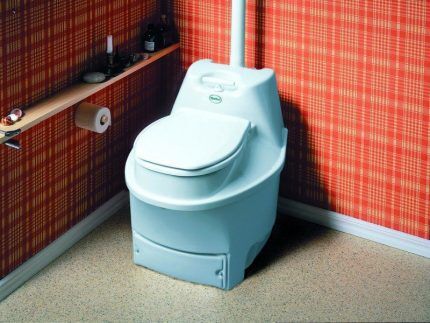
The hygienic device has a spacious lower compartment, into which a durable bowl is installed. A layer of peat is poured onto the bottom of the container. The compartment is closed from above with a lid in which a hole and a seat are made. On top of the peat models there is a small container resembling a regular tank. It is also filled with dry peat.
Sewage immediately falls into the bowl with the filler; as it is filled from the upper compartment, the tank, additional portions of peat or peat mixture are added using a dispenser. To do this, you need to turn the lever on the body of the device: it activates the dispenser, which is responsible for the uniform distribution of the substance.
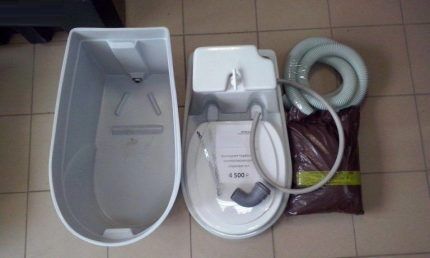
It is clear that in this model, odors are retained less easily than when using liquid hygiene devices. Therefore, it is recommended to install a peat toilet only in private houses, in a separate, well-ventilated room. For a city apartment, this option is categorically unacceptable.
On our website we have a comparative review of peat, liquid and chemical dry closets. To decide on the best option for a dry closet, please go to this link.
Peat models have two undoubted advantages. Waste is turned into valuable fertilizer, and the design is so simple that you can make it yourself from available materials.
But in any case, you will need a place to store waste peat (usually a compost pit). The neutralizer also needs a special one: dry, free-flowing, the presence of lumps is not allowed. Such peat is bought in stores.
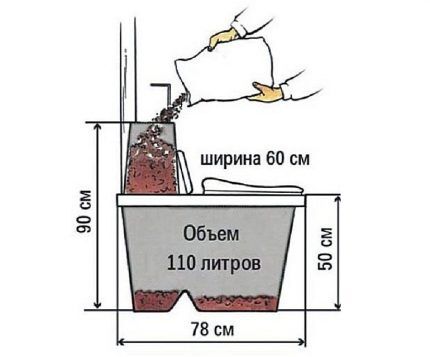
There are separator models of dry closets.These are electric options, similar to peat ones, that process waste into the starting material for compost heaps. During processing they do not use either peat or liquid; the action is based on drying and pressing.
In electric models, liquid waste is separated from solid waste, diverted outside by a hose and immediately disposed of in the ground. Such devices can be made “two-story”: the toilet itself is placed on top, and containers for collecting sewage are placed under it or even hidden under the floor. This partially solves the problem of unpleasant odor.
Haven't purchased a dry closet yet and are just looking for the right option? In this case, we recommend that you read rating of the best models, which are in active demand among buyers.
Cleaning and maintenance procedures
Over time, the dry closet needs to be cleared of accumulations.
This is done simply:
- Remove the waste container.
- Move them to the sewer, compost pit, etc.
- Clean the container from remaining contaminants.
- Add a fresh portion of the neutralizing agent.
- Place the tank in place.
But for each model there are certain nuances. They are usually described in detail in the instructions that accompany the device.
Instruction #1 - cleaning the liquid model
Recycling containers in such devices fill up quite quickly, so they need to be cleaned frequently. It is important to disassemble the device correctly so as not to break it. The procedure depends on the structural features of a particular model.
For example, an Enviro 10 composting toilet is cleaned as follows:
- First you need to check the condition of the drain valve; it must be closed.
- Now you should slide the side latches and remove the top part of the device.
- After this, the lower container can be taken by the handle and taken to the waste disposal site.
- The tank is turned over to a vertical position.
- Then you need to slowly open the lid from the drain hole.
- Wait until the gases accumulated inside the container come out.
- Dispose of waste down the drain or into a compost storage area.
- Wash both containers.
- Reassemble the device in reverse order: close the lid, secure the position with latches, check the drain valve.
- Fill the containers with appropriate liquids.
Pour the contents of the tank through the liquid filling hole. The gap located in the top center cannot be used for these purposes; it must be blocked by a valve. This model does not have an indication that the tank is full, so the need for cleaning is indicated by the inability to drain the water normally.
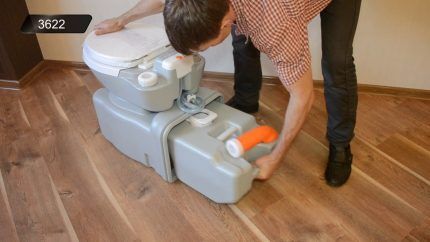
Understanding how often such a toilet needs to be cleaned will come with time.
Liquid dry toilets require regular maintenance. They need to be cleaned in much the same way as a regular toilet, using household chemicals.
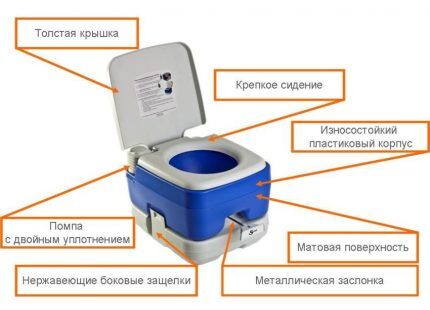
But you need to make allowances for the fact that plastic can be damaged by aggressive substances. Manufacturer's instructions should be followed. A brush that is too hard can cause mechanical damage.
Instruction #2 - peat toilet maintenance
Such models fill much more slowly than their liquid counterparts. Depending on the intensity of use, the container with peat and waste must be emptied once every six months to a year, and sometimes only once every few years. This is not difficult to do, since the design of such devices is very simple.
The mixture of peat and sewage is in a plastic container under a lid with a seat. You need to lift this lid and pull out the container. It is usually equipped with a convenient carrying handle. After this, the container with the filler is taken to a compost pit or other place provided for the disposal of such waste.
The contents of the container are poured out or shaken out. After this, you need to wash the container, add a layer of prepared peat to its bottom and put it in place. The toilet can be used again. For separator models, the cleaning scheme is absolutely the same, but due to drying and pressing, they have to be emptied much less frequently.
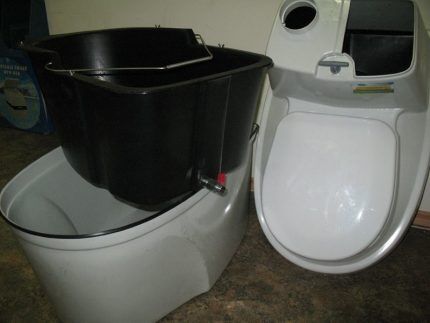
Of course, such a dry closet should be regularly cleaned of current contaminants. To do this, you can use familiar household chemicals.
It should be remembered that some manufacturers do not recommend cleaning such devices with compounds containing chlorine, concentrated acids and other aggressive chemicals.
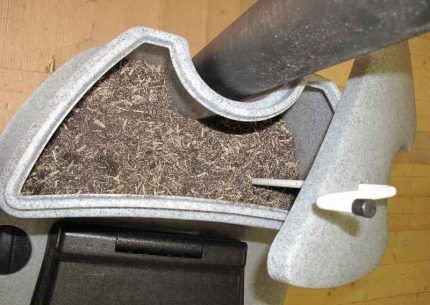
It is not recommended to throw used toilet paper into a peat toilet. Such inclusions will make the filler inhomogeneous and impair the processing process. For liquid models, only certain types of toilet paper can be recycled.
If desired, the peat filler can be supplemented with sawdust if it is available on the site. The materials are mixed in a 1:1 ratio. But the sawdust should be small, and the total volume of filler in the container should be large enough. It is not recommended to use such an addition for small dry closets.
If desired, you can make a peat toilet model with your own hands. We discussed how to do this correctly and what materials will be needed in next article.
Conclusions and useful video on the topic
How to use a dry closet correctly:
Cleaning the peat model:
A composting toilet needs to be cleaned regularly to ensure it performs as expected. This is not a very complicated procedure, you just need to follow the instructions so that the process goes quickly and efficiently.
Are you planning to start servicing your dry closet, but still have questions after reading the material above? Ask our experts in the block below.
Or maybe you want to share useful tips on proper care of your dry closet with other users? Write comments and share your experience under this article.




We bought a peat dry toilet for our dacha and placed it outside, equipping it with a summer toilet box. Since we have a vegetable garden, we use fertilizer that has rotted in a compost pit.Peat is also a fertilizer for the soil, so we pour the contents of the dry closet into the compost pit, wait for it to rot and fertilize the soil. Installed outside due to the smell.
In the summer, my wife and I live at the dacha 4-5 days a week and use a dry closet. Unfortunately, with such operation, the chemicals do not have time to completely process the contents of the dry closet and cleaning it is not a very pleasant task. Has anyone encountered this? Will replacing the chemical with a different brand or something else help?
In this case, it makes sense to choose another chemical manufacturer. I can also recommend considering the option of a peat toilet. It is quite easy to maintain:
— dry peat is changed every few months (can be buried on the site);
— the container with peat is located under the cabin and can be easily removed;
— you need a small container to drain the liquid (just in case).
The advantage is that no chemicals are used, but natural peat, which does not need to be transported far and disposed of. The article also has a video showing how easy it is to maintain such a toilet. What chemicals are you using now?